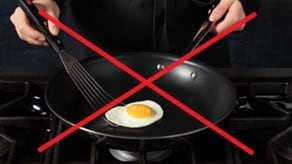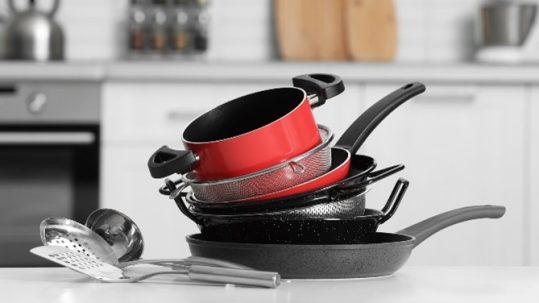Maximize the longevity of your non-stick cookware with these seven essential tips. From proper utensil usage to careful cleaning techniques, learn how to protect and preserve your kitchen investment for years to come.
1. Refrain from using utensils made of metal.
Using metal utensils on non-stick surfaces can cause scratches and chips, compromising the coating’s integrity over time. Opt for utensils made of wood, plastic, silicone, or nylon to preserve the non-stick surface and ensure longevity for your cookware.

2. Ensure safe handling.
Improper storage of your pans, particularly stacking without liners, can lead to scratches and damage, especially if done to save space. Avoid stacking pans directly on top of each other to prevent abrasions and maintain the integrity of your cookware for longer-lasting use.

3. Steer clear of high temperatures.
Non-stick cookware is not suitable for high-heat cooking, as it can compromise the coating’s integrity. For tasks like searing or frying, opt for stainless steel or cast iron cookware, which can withstand higher temperatures without risking damage. While most non-stick pans are oven-safe, it’s crucial to adhere to the manufacturer’s guidelines and avoid baking at temperatures exceeding 260°C to prevent potential damage to the coating. Always prioritize safety and follow recommended usage instructions for optimal performance and longevity of your cookware.
4. Hand-wash.
Washing non-stick pans by hand is essential to preserve their coating and ensure longevity. Despite manufacturer claims of dishwasher safety, exposing them to the dishwasher’s high temperatures, steam, and abrasive detergents can gradually degrade the non-stick surface. Instead, gently hand-wash the pans using warm, soapy water and a soft sponge to avoid damaging the coating. Avoid harsh scrubbing tools like metal brushes, as they can scratch and compromise the non-stick surface. After washing, thoroughly dry the pan to prevent water spots and potential rusting, prolonging its lifespan and maintaining its non-stick properties for years to come.

5. Avoid leaving food in the pan.
Leaving food in a non-stick pan for extended periods, especially acidic substances like tomato sauces, lemon juice, or wine, can gradually wear down the coating. Even if it is just for a short while, the acidity can slowly degrade the non-stick surface, compromising its effectiveness over time. To preserve the integrity of your non-stick cookware, it is best to transfer any leftover food to storage containers or refrigerate them in separate dishes rather than leaving them in the pan. This simple practice helps prevent the deterioration of the non-stick coating, ensuring your pans remain in optimal condition for longer use.
6. Avoid drastic temperature changes.
Changes in temperature can lead to warping. To prevent this, avoid sudden shifts in temperature by gradually heating and cooling the pan. The primary cause of warping often involves rinsing a hot pan with cold water. Always allow the pan to cool completely before washing it.
7. Avoid cutting food directly in the pan.
Using sharp utensils or knives to cut ingredients while they cook in the pan is a surefire way to damage the non-stick coating. Instead, transfer the ingredients to a cutting board before cutting them to avoid damaging your pan.
Conclusion
By following these tips, you can significantly extend the life of your non-stick cookware, ensuring that it remains in top condition for many delicious meals to come. Proper care and maintenance are essential for preserving the functionality and longevity of your kitchen tools.




